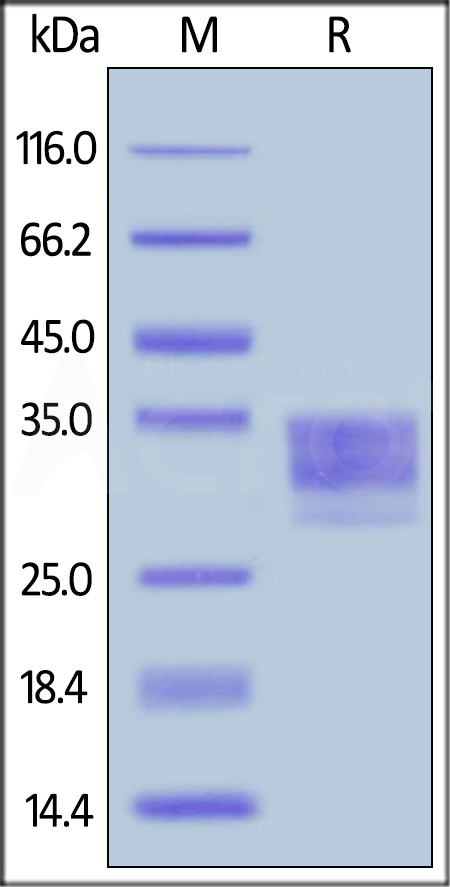Recombinant Mouse Low Affinity IgG Fc Receptor IV/FcgR4/CD16-2 (C-6His)

Fig. 1: Mouse CD16-2, His Tag on SDS-PAGE under reducing (R) condition. The gel was stained overnight with Coomassie Blue. The protein has a calculated MW of 21.9 kDa. The protein migrates as 28-35 kDa under reducing (R) condition (SDS-PAGE) due to glycosylation. The purity of the protein is greater than 90%.
Roll over image to zoom in
Shipping Info:
For estimated delivery dates, please contact us at [email protected]
| Amount : | 50 µg |
| Content : | Lyophilized from a 0.2 µm filtered solution of PBS,pH7.4. |
| Storage condition : | Lyophilized protein should be stored at -20°C, though stable at room temperature for 3 weeks. Reconstituted protein solution can be stored at 4-7°C for 2-7 days. Aliquots of reconstituted samples are stable at -20°C for 3 months. |
| AA sequence : | GLQKAVVNLDPKWVRVLEEDSVTLRCQGTFSPEDNSIKWFHNESLIPHQDANYVIQSARVKDSGMYRCQTALSTISDPVQLEVHMGWLLLQTTKWLFQEGDPIHLRCHSWQNRPVRKVTYSQNGKGKKYFHENSELLIPKATHNDSGSYFCRGLIGHNNKSSASFRISLGDPGSPSMFPPWHQVDHHHHHH |
Source: Human Cells.
MW :21.9kD.
Recombinant Mouse Low Affinity Immunoglobulin Gamma Fc Region Receptor IV is produced by our Mammalian expression system and the target gene encoding Gly21-Gln203 is expressed with a 6His tag at the C-terminus. Fcgr4, also known as CD16-2, is one of the receptors for Fc region of IgG which involve in immune responses. Fcgr4 mainly functions in cellular response to lipopolysaccharide, NK T cell proliferation, regulation of sensory perception of pain, wound healing etc. Three groups are included for Fc gamma receptors (FcR), and they are Fc gamma RI (CD64), Fc gamma RII (CD32), and Fc gamma RIII (CD16). Among these, CD64 possess high affinity even for monomeric IgG, while CD32 and CD16 display a relative lower affinity for IgG. Genes encodes these receptors are diverse differing by species and cell types. The aggregation of FcR having immunoreceptor tyrosine-based activation motifs (ITAMs) activates sequentially src family tyrosine kinases and syk family tyrosine kinases that connect transduced signals to common activation pathways shared with other receptors. FcR with ITAMs elicit cell activation, endocytosis, and phagocytosis. Fcgr4 belongs to Fc gamma RIII (CD16) group.
Endotoxin : Less than 0.1 ng/µg (1 IEU/µg) as determined by LAL test.
For Research Use Only. Not for use in diagnostic/therapeutics procedures.
Wagner JT, Müller-Schmucker SM, Wang W, Arnold P, Uhlig N, Issmail L, Eberlein V, Damm D, Roshanbinfar K, Ensser A, Oltmanns F, Peter AS, Temchura V, Schrödel S, Engel FB, Thirion C, Grunwald T, Wuhrer M, Grimm D, Überla K.
Influence of AAV vector tropism on long-term expression and Fc-? receptor binding of an antibody targeting SARS-CoV-2.
Commun Biol. 2024 Jul 16;7(1):865. doi: 10.1038/s42003-024-06529-3.
PMID: 39009807; PMCID: PMC11250830.
Richel E, Wagner JT, Klessing S, Di Vincenzo R, Temchura V, Überla K.
Antigen-dependent modulation of immune responses to antigen-Fc fusion proteins by Fc-effector functions.
Front Immunol. 2023 Oct 5;14:1275193. doi: 10.3389/fimmu.2023.1275193.
PMID: 37868961; PMCID: PMC10585040.
| Subcellular location: | Cell membrane |
| Post transnational modification: | Phosphorylated following receptor ligation. |
| Tissue Specificity: | Detected on myeloid cells, peripheral blood monocytes, splenic and bone marrow dendritic cells, and thioglycollate-elicited macrophages and neutrophils but absent from lymphoid populations with no expression observed on T cells, B cells, NK cells or other granulocytes (at protein level) (PubMed:16039578, PubMed:19795417). Expressed in peripheral blood leukocytes, spleen, liver, thymus and small intestine (PubMed:12389094, PubMed:17558411). |
|
There are currently no product reviews
|














.png)









